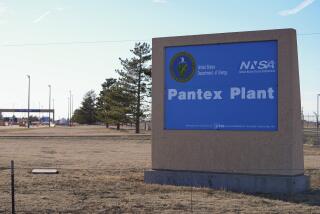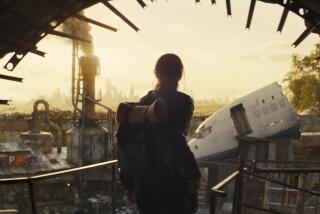Nuclear Lab Showcases Mixing Arms Control and Development
ALBUQUERQUE, N.M. — Roger Hagengruber views a new building at Sandia National Laboratories as a metaphor for the changing world of the nuclear weapons lab since the demise of the Cold War.
The Center for National Security and Arms Control represents the world that Sandia faces in the 21st century--not just arms control, not just nuclear weapons development, but both, he said.
“The window of the Cold War sort of opened up. We’re putting some blocks on the sill to make sure it never closes again,” said Hagengruber, vice president for national security programs at Sandia.
Escorted visitors are welcome in about 40% of the new $34.5-million center, where American scientists work with researchers from the former Soviet Union and other nations.
They take on a variety of issues, including cooperative arms control, stopping nuclear proliferation and keeping weapons out of the hands of terrorists.
The endeavor also includes the Cooperative Monitoring Center, in an industrial park away from Sandia’s location on Kirtland Air Force Base. The monitoring center is meant as a neutral place for foreign visitors to learn about nuclear monitoring and verification.
The restricted areas of the project at Kirtland include work on such things as national security analysis and nuclear weapons planning. The scientists collaborate with counterparts in other nuclear nations to safeguard weapons and redirect nuclear technology to commercial uses.
Researchers at the national security center and throughout Sandia work on ways to protect stored nuclear weapons materials, design technology to detect manufacturing associated with nuclear, chemical and biological weapons, and assess foreign technology for potential threats.
Hagengruber’s office bookcase displays various small sensors used to detect illegal activity in the movement of weapons, a fiberoptic seal for nuclear weapons containers, a model of a container for storing the cores of nuclear warheads and two plastic paperweights--one Russian, one American--filled with pieces of crushed, dismantled bombs.
“Peace does not come nor does it stay just because war’s bad or because people would rather be at peace than at war,” Hagengruber said.
“There’s a proactive part of it that demands that there be a citizen science that serves the national interest, that recognizes there’s a balance between being a strong and powerful nation and being a nation that can reach out a hand and take a risk,” he said.
Today’s nuclear sensors are so sophisticated that an instrument the size of a small tape recorder can detect the presence of nuclear materials in tiny quantities.
But it is much harder for Sandia to develop sensors and detectors for chemical and biological agents because there are so many of them, Hagengruber said.
Biological sensors are in their infancy because there’s been little reason to develop them, he said.
“It is not easily detectable, or else we’d say, ‘Oh, look, the flu just came in the door,’ or, ‘I shouldn’t go over there; there must be some E. coli in that room.’ But the fact is, it is very difficult. Each detector has to be designed around the biological species,” Hagengruber said.
It’s easier to recognize chemicals, he said, or the rapid improvement of technology. It’s already possible to tailor a small computer chip to analyze specific chemicals and detect them in low quantities in a room.
Sandia has a four-decade history of arms treaty verification work, everything from satellite monitoring to on-site technology. Such technology has made it possible for nations to take a chance on peace, Hagengruber said.
“So when a country says, for example, ‘Let’s have a demilitarized zone and we’ll put sensors in there,’ it’s not possible that you have everything,” he said. “In effect, the risk that you bear will in fact go up in some mechanical sense because what you’ve done is said that you’re going to give visible symbols of trusting someone else.”
For example, although the former Soviet Union objected to on-site inspections of its nuclear facilities, technology developed at Sandia and Los Alamos national laboratories to detect nuclear explosions in the atmosphere made a limited test ban treaty possible, Hagengruber said.
A pact to reduce intermediate-range missiles came about after Soviet officials toured a Sandia program and became convinced that verification was possible, he said.
Sandia also designed technology that enables the International Atomic Energy Agency to monitor nuclear materials around the world.
“If you go to Taiwan and look at the reactor in Taiwan, you’ll see a camera that had its design origins here at Sandia that monitors the spent fuel, the plutonium-bearing fuel,” Hagengruber said. “There are literally hundreds of those, perhaps even thousands of those around the world” to ensure nuclear material won’t be diverted to making bombs.
National labs also traditionally have helped the intelligence community assess potential threats.
“The better we are at understanding the problems, the better we are at predicting and offering the technologies [to solve them],” Hagengruber said.
He offers a “semi-hypothetical” example: trying to get North Korea to control its nuclear materials.
“The only way we really know or can guess how much material North Korea has is to understand what their reactor is capable of producing. Then we have to understand whether it’s operated or not and, if it has operated, how much it’s operated. Then we try to estimate how much material they actually have.
“And then when they say, ‘We finally do agree, let’s protect this material,’ we have some kind of an independent judgment about how much material they actually have.”
Nuclear labs have been accused of being the mechanism behind the escalation of the Cold War--that their advances fueled the drive for more and better weapons in the United States and Soviet Union.
But Hagengruber argues Sandia also has been aware that “it’s not all about building nuclear weapons, and that every nuclear weapon and every change in a nuclear weapon is not a good thing to do.”
Hagengruber said the last decade was marked by emerging cooperation between nations. “The country must have the best defense that it can have, but it should have no more defense than it needs. . . . The hand that holds the sword must also be willing to reach out a hand for peace because in this country our traditions are not to own weapons in order to wage war, but, really, to defend this country,” he said.
More to Read
Sign up for Essential California
The most important California stories and recommendations in your inbox every morning.
You may occasionally receive promotional content from the Los Angeles Times.










